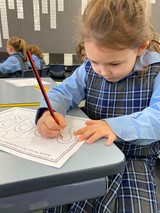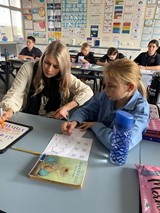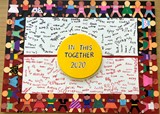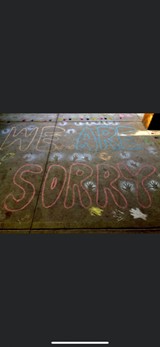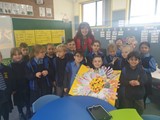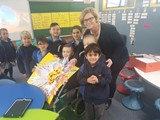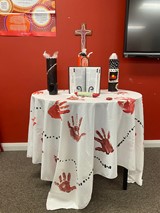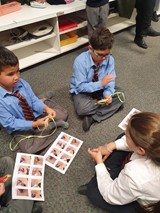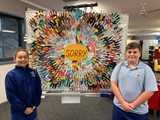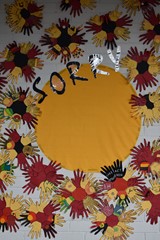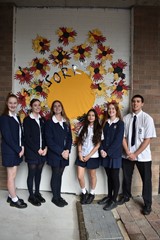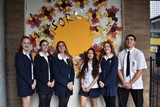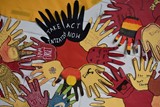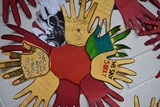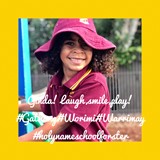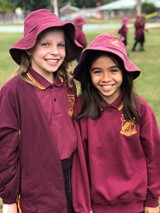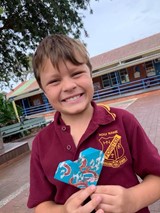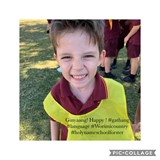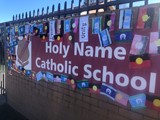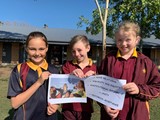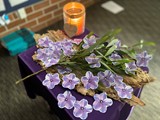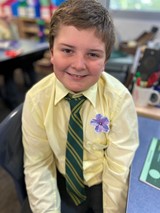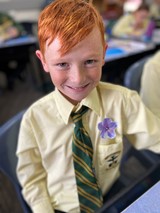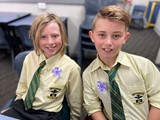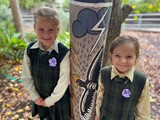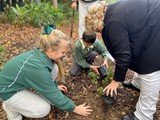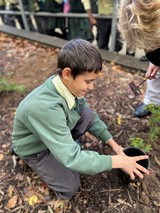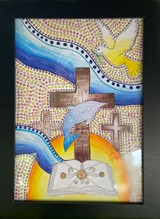St Mary’s Primary School, Scone
Aboriginal student Cecelia was invited to participate in the Upper Hunter Council Flag Raising Ceremony on Wednesday 27 May, however, due to the NSW COVID-19 restrictions, the event was live-streamed. We gathered as a school to recognise Sorry Day, listen to Cecelia’s insights and share our thoughts on what the day means to us.
We also celebrated Reconciliation Week by creating a whole-school artwork based on this year’s theme In This Together. Children were invited to sign their names to show their individual support of healing the relationship between indigenous and non-indigenous Australians. The artwork hopefully shows that when individuals come together, we can raise a strong, collective voice for justice and equality for all.
St James’ Primary School, Muswellbrook
St James’ Primary School, Muswellbrook participated in a variety of activities during Reconciliation Week. Our younger students have loved learning about caring for country, bush medicines and trying out their skills at weaving.
Our older students have tackled some of the big topics around reconciliation such as the impact of the Stolen Generation.
The Stage 3 students showed great maturity and awareness of current issues affecting Aboriginal and Torres Strait Islander peoples during our activities based on the recently released documentary In My Blood It Runs. All students have been given the challenge to be involved in some way with reconciliation in Australia as we’re In This Together.
St Paul’s Primary School, Gateshead
At St Paul’s Primary School, Gateshead students acknowledged National Reconciliation Week by sharing a video clip of ESL teacher Sue Coull reading the story Sorry Day by Coral Vass and Dub Leffler. This video featured on the school’s website and Facebook page.
St Paul’s Aboriginal Education teacher, Lisa de Forges, also made reconciliation hands with a number of students and classes.
“It is a time to celebrate and build on positive and respectful relationships and connections between Australians and Aboriginal and Torres Strait Islander people,” said principal Greg Cumming. “This reconciliation helps create a positive change and helps Australians learn about their shared histories, cultures and achievements.”
Students at St John the Baptist, Maitland participated in a whole-school mural and a variety of in-class acknowledgements and activities. Year 5 students recorded a video of them singing the National Anthem in the Awabakal language.
St Joseph’s Primary School, Wingham
The students at St Joseph’s Primary School, Wingham spent some time with Aunty Kylie, our Aboriginal education worker, learning about how we are part of the journey to create a just and equitable nation through unity, respect and connection. We took time to reflect on the past and think about the value of Aboriginal and Torres Strait Islander peoples, their history and culture.
St Mary’s Primary School, Warners Bay
At St Mary's Primary School, Warners Bay we asked all students to decorate a hand in the colours of the Aboriginal and Torres Strait Islander flags, and we combined them to make a striking poster, which is on display in the library. We also used PowerPoints and other classroom activities to spark thoughtful discussions about Reconciliation Week.
St Brigid’s Primary School, Raymond Terrace
We started National Sorry Day with a whole-school prayer, but all from within our own rooms. Every class created their own scared space within their room, which included paperbark from the local melaleuca trees, some greenery from our school Aboriginal garden, paper native hibiscus flowers (the official flower of Sorry Day), their class candle, bible and cross. We had a PowerPoint to work our way through that included listening to a Stolen Generations survivor, prayers, singing and concluding with the Aboriginal Our Father. At the completion of the prayer, every student and staff member was encouraged to take a paper flower from the scared space and wear it on their uniform for the day as a sign of commitment. Later we planted two native hibiscus plants in our Aboriginal garden to mark the day.
Reconciliation Week, again due to restrictions, was observed within individual classrooms. We began the day with the reveal of an artwork by one of our Year 5 Aboriginal students, Imani Brind. Imani was asked to design and create an artwork that represented who we are as a Catholic school, on Worimi land, in Raymond Terrace, which sits on the junction of two rivers, the Hunter and the Williams. She produced an amazing artwork that will be a focal point for our school for many years to come.
Over the course of the week, classes were able to participate in a range of activities from a Reconciliation Week PowerPoint. These included learning a song in Gathang, the local Aboriginal language, analysing the lyrics of Paul Kelly's This Land is Mine, discussing racism after viewing the Adam Goodes story, or playing a Kahoot to test reconciliation knowledge.
Holy Name Primary School, Forster
It is only 20 years since Australians walked across the nation in support of a more reconciled Australia. At Holy Name Primary School, Forster we realised that some students may not understand that it's only a relatively recent shift in Australia's thinking and that National Reconciliation Week is an opportunity to share knowledge and encourage understanding in our youngest community members.
From 27 May to 6 June teachers planned activities in classrooms to encourage conversation and learning about reconciliation and the impact of white settlement on Australia's indigenous people. We also made it a time to celebrate and pay respect to our local Worimi community. As NAIDOC Week was postponed to later in the year due to COVID-19, we decided to really make this a special occasion. At the beginning of the week, every classroom received a beautiful candle designed by a local indigenous artist. Using the reconciliation candle, teachers created a reconciliation prayer space in their classrooms. Every student painted the indigenous and Torres Strait Islander flags, which we proudly displayed on the school fence and around the school.
In Term 1, every class worked with our Aboriginal Education staff to create a class Acknowledgment to Country. During Reconciliation Week, students were asked to revisit the discussion they had when they chose the significant wording in their class Acknowledgement to Country and to pay respect to our indigenous community and elders past and present.
Teachers were provided with a bank of Reconciliation Week resources including videos and art activities and were asked to embed the theme of In This Together into the rhythm of their classroom. We are blessed to have local Worimi woman Crystal Simon as an Aboriginal Education Worker here at school. Crystal shared the Gathang language to complement photos of our students we shared with the community. On Tuesday 2 June staff gathered after school to view and discuss the recently released In My Blood It Runs, an observational feature documentary following 10-year-old Arrernte boy Dujuan as he grows up in Alice Springs.
The Holy Name School community is praying for peace and reconciliation worldwide and hopes that by increasing awareness and understanding at our local level, we can truly be In This Together.
St Pius X High School, Adamstown
Celebrations for National Reconciliation Week looked a little different this year, with the teachers and students of St Pius X High School, Adamstown taking a digital approach to kicking the week off.
Staff were eager to come together to celebrate the 2020 theme In This Together, which involves building positive, respectful relationships between Aboriginal and Torres Strait Islander peoples and other Australians. St Pius X hosted an online screening of the film In My Blood it Runs, in line with the launch of the #LearnOurTruth campaign and participated in a variety of classroom workshops, online forums and discussions.
St Joseph’s College, Lochinvar
As part of St Joseph’s College, Lochinvar’s celebrations, all students and staff participated in a Learning Mentor group presented by Year 12. Students also created a “Sea of Hopeful Hands” on their Bertrand Centre windows. The hands — which were in the colours of the Aboriginal and Torres Strait Islander flags — contained messages of hope, unity, and reconciliation.
A Reconciliation Timeline was displayed around the school outlining important historical dates for the Aboriginal community. The documentary In My Blood It Runs, which follows a young Aboriginal man in his quest to find himself as he struggles with Western ways, was also screened for Year 10 History and all Aboriginal students.
St Paul's Catholic College, Booragul
Reconciliation week is an important event in our nation’s calendar. This year at St Paul’s it was a bit different as a result of social distancing measures, but still just as meaningful.
For Sorry Day on 26 May, our Year 10 students prepared the traditional hands with messages of support and the significance to them of Sorry Day and Reconciliation Week. Year 12 used them to create hand wreaths, which they placed on our socially distanced Sorry Wall mural.
Over the past few terms our First Nations students collaboratively created an Acknowledgement of Country unique to our school community and we shared this on Sorry Day.
Throughout Reconciliation Week our students completed activities in their CARE groups acknowledging and learning more about the significance of Sorry Day and Reconciliation Week for all Australians to repair and strengthen our relationships with one another and work towards healing the pain colonisation inflicted on our First Nations people.



